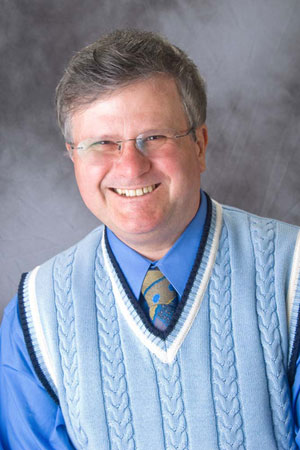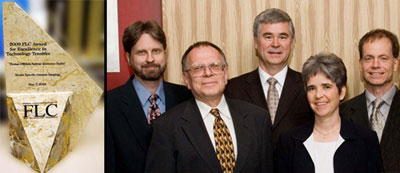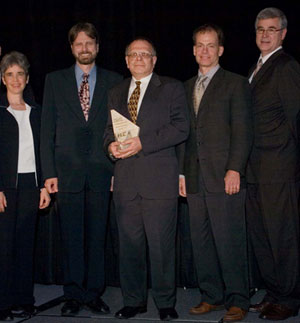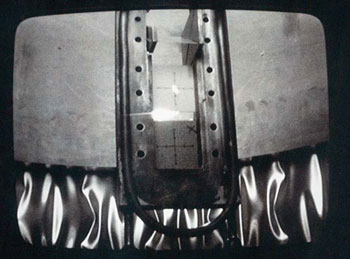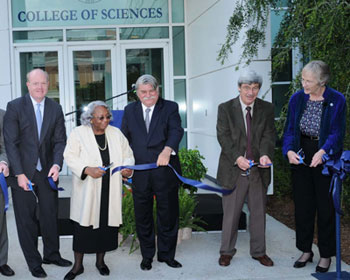
|
July 2009
|
|
|
The U.S. Department of Energy's Thomas Jefferson National Accelerator Facility
|
|
JLab Chief Scientist Named Fellowship Winner |
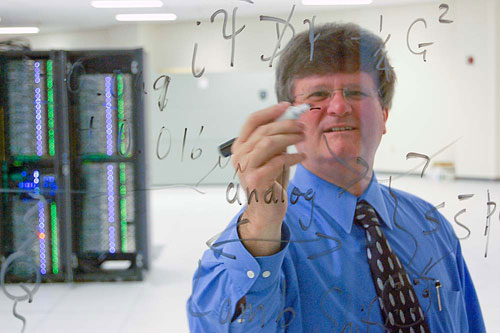
Anthony W. "Tony" Thomas, Jefferson Lab's chief scientist, is one of 15 world-leading scholars selected to receive an inaugural Australian Laureate Fellowship. He will return to the University of Adelaide later this year to take up the fellowship and lead the newly created Research Centre for Complex Systems and the Structure of Matter.
Jefferson Lab's chief scientist is one of just 15 world-leading scholars selected to receive an inaugural Australian Laureate Fellowship. Anthony Thomas, who joined Jefferson Lab in 2004, will receive about $3 million over five years to conduct research, according to Sen. Kim Carr, Australia's minister for Innovation, Industry, Science and Research. The 15 fellowships will support the work of up to 60 postgraduate and postdoctoral researchers, who will work with the laureates. Thomas will return to the University of Adelaide later this year to take up the Fellowship and lead a new Research Centre for Complex Systems and the Structure of Matter. There, he will lead a team of theoretical physicists with skills in mathematical modeling and high-performance computing....... more |
|
|
Guy Ron Nabs 2008 JSA Thesis Prize |
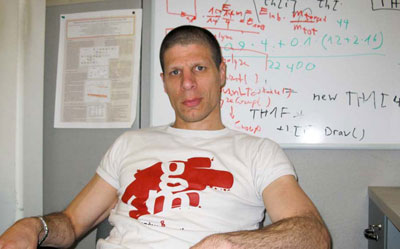
Jefferson Lab user Guy Ron, who earned his doctorate from Tel Aviv University, won the 2008 JSA Thesis Prize for his work on low-energy proton form factors. The prize is awarded annually for the best Ph.D. dissertation resulting from research performed at Jefferson Lab.
Jefferson Lab User Guy Ron has won the 2008 JSA Thesis Prize for his work on low-energy proton form factors. The prize is awarded annually for the best Ph.D. dissertation resulting from research performed at Jefferson Lab. Ron’s, The Proton Elastic Form Factor Ratio at Low Q2, furthers our understanding of the structure of the proton. "The proton is not a point particle. It has some structure inside it, particles known as quarks. These quarks are charged and they're moving around," said Ron, who earned his doctorate from Tel Aviv University in Israel. The proton contains three quarks, and each quark carries an electric charge and magnetic moment. As they move, the charged quarks produce a magnetic field. The result of quarks moving around inside the proton is a distribution of electric and magnetic fields. "We measured how these electric and magnetic distributions are different from each other," Ron explained. The data Ron and his colleagues collected for his thesis experiment prompted the scientists to follow up with a dedicated, more precise measurement of the proton last fall. The result will be published soon. In addition, Ron is involved in another, high-precision run that will continue the research. "This part, which is currently on the schedule for 2012, will measure the same quantity at even lower energies in a different technique," he said. In the meantime, Ron has changed his research focus to physics beyond the Standard Model. He's using lasers to trap radioactive atoms to study the radiation the atoms give off. 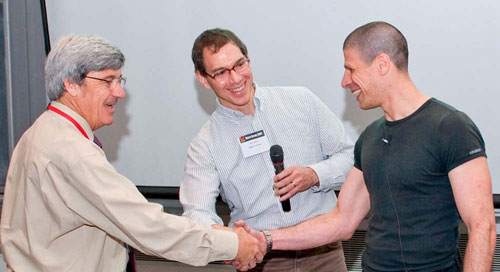
Lab Director Hugh Montgomery (from left) and outgoing Users Group Board of Directors Chair Ron Gilman congratulate Guy Ron, winner of the 2008 JSA Thesis Prize. The award was presented during a session at the JLab Annual Users Group Meeting. More highlights from the meeting will be in the next issue of On Target.
"This is weak interaction physics. It's beyond Standard Model physics but in a different energy range, in a very-low-energy range, complementary to all these high-energy experiments," he said. "It's a very different technique, but it's the kind of experiment that's very complementary to experiments like Q-weak and others," Ron said. When notified that he had won the prize, Ron was initially surprised. "In Hebrew, you translate this as the imposter syndrome. You feel like an imposter; people are handing you things you couldn't possibly deserve. And I definitely could not have done any of the work without the people in my collaboration. Everybody else worked really hard on it, and it is as much their award as mine," he said. Ron Gilman, the chairperson of the Jefferson Lab Users Group Board, which oversees selection of the winner, said the board was impressed with the quality of nominations for this year's prize. "The students did excellent research. What particularly set Guy Ron above the other students was that he proposed, defended and led the running of a follow-up experiment to his own Ph.D. research, all while still in graduate school." Ron presented his thesis work at the Users Group Workshop and Annual Meeting at Jefferson Lab on June 8-10. The Thesis Prize was established in 1999 by the Southeastern Universities Research Association, the predecessor management and operating contractor for Jefferson Lab. It is awarded to a graduate student who has carried out research related to Jefferson Lab science. It is awarded for the best graduate student thesis and includes an award of $2,000 and a commemorative plaque. Four areas are considered in rating a submitted thesis: the quality of the written dissertation, the student's contribution to the research, the work's impact on the field of physics and service (how the work benefits Jefferson Lab or other experiments). The Thesis Prize is one of many projects supported by the JSA Initiatives Fund, a program funded by the JSA owners (SURA and CSC/ATD) to support efforts that further the scientific outreach and promote the science, education and technology missions of Jefferson Lab and the lab’s user community. The annual commitment of $500,000 is administered by the JSA Programs Committee. For more information about the program, see http://www.jsallc.org/IF/IFIndex.html. By Kandice Carter Editor's note: Catch the next issue of On Target for results of the JLab Users' Group Meeting poster contest. |
NuTeV Anomaly Helps Shed Light on Physics of the Nucleus |
|
A new calculation clarifies the complicated relationship between protons and neutrons in the atomic nucleus and offers a fascinating resolution of the famous NuTeV Anomaly. The calculation, published in the journal Physical Review Letters on June 26, was carried out by a collaboration of researchers from Jefferson Lab, Tokai University and the University of Washington. It grew out of attempts to make sense of the complex environment found in the nucleus of the atom. "I was at CERN when the EMC Effect was discovered more than 20 years ago," said Anthony Thomas, Jefferson Lab Chief Scientist and an author on the paper. "It's such a fundamental piece of information about the structure of nuclei that I wanted to understand it." Thomas and his colleagues, Ian Cloët, a JSA Thesis prize winner in 2008, and Wolfgang Bentz, a long term visitor at Jefferson Lab in 2008, had theorized that the internal structures of protons and neutrons are modified by the presence of other protons and neutrons inside the nucleus. Meanwhile, another landmark result, the NuTeV Anamoly, provided Thomas and his colleagues with another puzzle regarding the nucleus. Experimenters at Fermilab's NuTeV (Neutrinos at the Tevatron) experiment sent a beam of neutrinos into a steel target and measured the ratio of two types of subatomic particles – neutrinos and muons – that emerged. They found that about one percent fewer neutrino-target collisions produced neutrinos than predicted by the Standard Model. "Many people were convinced that they had discovered evidence for physics beyond the Standard Model," said Thomas. He and his colleagues pored over the experimental information and began applying their theories for the EMC Effect to it. They found that one common assumption that was used in the analysis of the NuTeV data involved a correction for a natural imbalance in the number of protons and neutrons in the nucleus of iron, the most common element in NuTeV's steel target. "The correction made for the extra neutrons involved a subtraction of the structure function of the extra neutrons," Cloët explained. "But according to our theoretical model of the EMC Effect, those extra neutrons generate a force that subtly changes the structure of every proton and neutron in the nucleus." The theorists went further, combining this newly discovered effect with another correction for the difference in masses of different quarks in the protons and neutrons (charge symmetry violation). When they applied the two corrections to the NuTeV analysis, they found that the experiment showed excellent agreement with the Standard Model. As a consequence, the NuTeV result may now be interpreted as providing crucial evidence for the idea that the structure of a proton or neutron is fundamentally modified when it is bound in a nucleus. This research was funded by the Office of Nuclear Physics within the Department of Energy's Office of Science. Paper link: I.C. Cloët, W. Bentz, and A.W. Thomas, Phys. Rev. Lett. 102, 252301 (2009) By Kandice Carter |
CEBAF, FEL Add Electronic Log Book to Personnel Safety Systems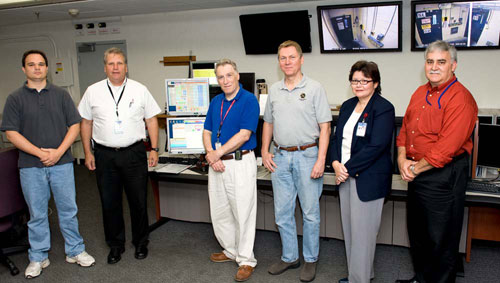
The JLab team that developed the new electronic log book for the CEBAF and FEL Personnel Safety Systems included (left to right): Theo McGuckin, Accelerator Division; Kelly Mahoney, Engineering Division; Terry Carlino, Accelerator Division; Henry Robertson, Engineering Division; Kim Kindrew, Information Technology Division and Noel Okay, Accelerator Division. Missing: Theo Larrieu, Accelerator Division.
The first electronic log book for the CEBAF and FEL Personnel Safety Systems (PSS) was officially commissioned on May 4. The PSS e-log is an electronic records management application (RMA) replacing the paper logbook system used over the last 20 years to record information related to PSS operations. The RMA is actually a collection of programs that work closely together to capture, validate, store and archive important PSS related information. Accelerator operators use PSS logs to record entries and exits from the accelerator beam enclosures during supervised accesses and to record changes in accelerator operating modes. During a controlled access, for example, operators must strictly account for each person entering and exiting a beam enclosure before re-starting beam operations. This information must then be accessible for at least as long as JLab is open and may eventually end up in the National Archives, in Washington, D.C. after JLab closes its doors. Development of the PSS e-log RMA involved staff from the Accelerator Operations Department, the Controls Software Group, Chief Information Officer/Information Technology Records Management and the Engineering Safety Systems Group. Because of the stringent requirements the U.S. National Archives has for electronic records, it took several years to first develop a stable electronic log (e-log) platform then an additional year to build on that system to create an even more robust version for the PSS e-log. Beta testing with the PSS e-log started in last summer and was completed before the introduction of the final release version in May 2009. During the beta tests, operators often used both the paper log and the electronic log. The final product is an important improvement to the CEBAF/FEL PSS operations. Going electronic has several advantages over the paper log. Like any electronic record, entries are stored in a searchable database, according to Kelly Mahoney, Engineering Group Leader for Safety Systems. The user interface also employs several information and qualification checks not practical with a paper log. For example, the PSS e-log alerts the safety system operator (SSO) to inconsistent entries, e.g. incompatible accelerator operational modes. The electronic log also helps with accuracy by implementing features to assist the SSO in accurately recording names and qualifications. Plans for future versions include secure tie-ins to other databases and automated metrics reporting functions. "I am truly impressed with both the final product and with the diverse group of professionals that worked so hard to put the PSS e-log system together," Mahoney said. “We are all proud to be part of another JLab first." The PSS is a system of engineered interlocks, access controls and warning devices used in the CEBAF and FEL accelerators to ensure people are not exposed to hazards present during accelerator operations. From the Machine Control Center, qualified accelerator operators remotely monitor access to beam enclosures site wide. Program Helps Grow Project Management Knowledge, Skills at JLab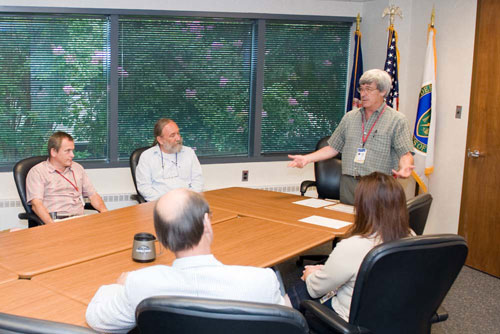
Lab Director Hugh Montgomery addresses a group that completed the JLab Project Management Qualification program.
Ever wonder how those project managers do it? How they get all those ever-changing elements and individuals into a cohesive group that gets a job done? Any Jefferson Science Associates employee whose job involves managing projects has the opportunity to learn the ins and outs for themselves, while gaining valuable experience, 23 Continuing Education Units and a certification in the process. Since July 2007, 34 people have completed the JLab Project Management Qualification (JPMQ) program. According to Bruce Ullman, the lab’s training and performance consultant, it was created to meet a contract requirement that JSA have staff members proficient in some of the essentials of the Project Management Body of Knowledge (PMBoK)® as it applies to JLab. The PMBoK is a universally-recognized collection of skills and procedures for managing projects effectively. Another eight individuals are currently in the process of completing the nine-course online portion, which is bracketed at the beginning and end by an in-person introduction and an integration led by Dennis Miner, program development engineer for the Project Management and Integration (PM&I) group. The challenging curriculum includes virtually every facet of project management: * Budgeting and Controlling Costs 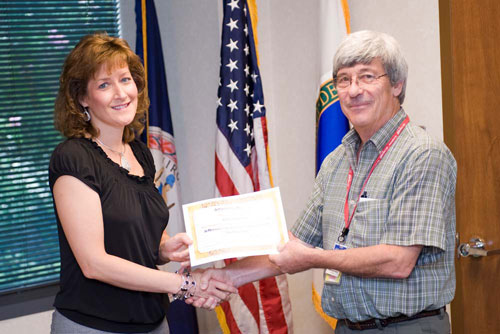
Lab Director Hugh Montgomery presents each individual with their certificate for successfully completing the program. Here he congratulates Kelly Webster, Accelerator Division.
Ullman estimates that each online course takes participants between two and three hours; the in-class introduction takes one hour and the integration component at the end, which includes going through a project scenario, takes about four hours. There are five or six people moving through the course work at any given time, and many individuals do the work in the evenings and on weekends. However, since it is considered to be job-related training, it may be accomplished during regular working hours. The first group to undertake the training was selected by PM&I Director Claus Rode and included the entire PM&I staff. Several staff members involved in the 12 GeV Upgrade project participated in the following session. Since that time, participants have come from all areas of the lab, and include all levels of staff. "We are encouraged by the way the staff is embracing this training, especially those who have voluntarily completed this program and those that have gone on to get their Project Management Professional certification," said Rode. "This [program] gives us a cadre of people who know how to manage projects the way we do it here, and ensures everyone is singing off the same sheet of music," Ullman noted, summing up the value of JPMQ for the lab. "Some people take the program because they know it will help them in their work, and others participate just because they find it all interesting." The post-course evaluations have all been outstanding. While some find the courses difficult, by the end they’ve come to appreciate it, he added. Getting involved is easy. Ullman can be reached at ext. 7170 and Dennis Miner can be contacted at ext. 7281. By Judi Tull JPMQ GraduatesAlphabetically listed below are current JLab staff members who have earned the JPMQ so far: Ken Baggett - Susan Brown - Brian Carpenter - Patrick M Collins - Gloria Daniel - Heidi Derby - Butch Dillon-Townes - L. Warren Funk* * Individuals that have gone on to get their Project Management Professional certification.
JLab Earns National Safety Council Awards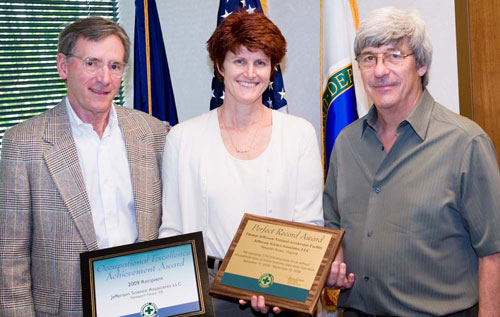
Jefferson Lab received two awards from the National Safety Council: the Perfect Record Award and the Occupational Excellence Achievement Award. Chief Operating Officer Mike Dallas (left), ESH&Q Associate Director Mary Logue and Lab Director Hugh Montgomery are shown with the two awards. The awards commend the JLab community's efforts to make and keep a safe work environment at the lab.
As a result of JLab staff, users and subcontractors' dedication and attention to safety, the lab recently earned two awards from the National Safety Council. The lab received the Perfect Record Award for operating from Nov. 11, 2006 to Sept. 10, 2008 without incurring an occupational injury or illness involving days away from work. That period accounted for 2,740,858 work hours. The award recognizes companies or facilities that have completed a period of at least 12 consecutive months without incurring an occupational injury or illness that resulted in days away from work or death. In addition, the lab earned the National Safety Council's Occupational Excellence Achievement Award for 2008. This award recognizes companies that have experienced injuries and illnesses that involved days away from work, at a rate equal to or less than the 50th percentile of the Bureau of Labor Statistics rate for similar industries. In addition these organizations have experienced no fatalities during that calendar year. "We can all be proud of these accomplishments and I congratulate everyone at the lab for making them possible," said Mary Logue, associate director for Environment, Safety, Health and Quality, after presenting the award plaques to Lab Director Hugh Montgomery and Chief Operating Officer Mike Dallas. 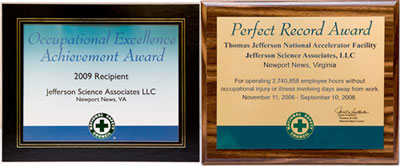
Click for bigger image
While commending the JLab community, Logue urges everyone to stay vigilant: "We mustn't allow ourselves to become complacent or get hurried and ignore or forget our sound safety practices," she added. "Summer is a time when we all look forward to some fun and relaxation, but that doesn't mean we can leave our safety guard down. "The only way to prevent injuries is for each of us to remain dedicated to planning our work and identifying and mitigating the hazards in the workplace – for ourselves and our co-workers." The National Safety Council is a non-profit, membership organization committed to preventing injuries and deaths at work, on the roads and in homes and communities. It engages organizations and individuals in research, education and advocacy and is a primary national resource on industry trends. JLab Earns HRSD Gold Award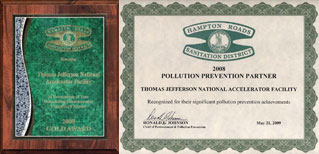
The Hampton Roads Sanitation District Pretreatment Excellence Gold Award plaque is shown on the left and the Pollution Prevention Partner certificate is on the right.
Click for bigger image Jefferson Lab has been recognized again for its environmental stewardship, recently earning a 2008 Hampton Roads Sanitation District Pretreatment Excellence Gold Award and a 2008 Pollution Prevention Partner certificate. Gold awards are presented to businesses that had perfect industrial wastewater permit compliance for an entire calendar year. The P2 Partner certificate recognizes businesses for significant pollution prevention achievements made during the year. The Hampton Roads Sanitation District (HRSD) held its annual awards luncheon on May 21 in Portsmouth. During the event, HRSD recognized businesses for exemplary permit compliance and outstanding P2 measures. A letter from HRSD reads, in part: "Congratulations …for exemplary permit compliance and outstanding pollution prevention measures. …[B]usinesses pretreat their industrial wastewater before discharging it to HRSD's system. Their efforts help protect our waterways and other natural resources. "Honoring businesses for their outstanding efforts provides deserved recognition and an incentive to maintain compliance and prevent pollution beyond environmental regulations." Pollution prevention awards are also presented to businesses for outstanding multi-media (water, land and air) efforts that focus on source reduction, rather than traditional treatment, control and disposal. Some examples include raw material substitution, installation of clean manufacturing technologies, in-process recycling, as well as preventive maintenance and spill prevention. In this regard, Jefferson Lab nominated P2 improvements offered by two groups for an HRSD pollution prevention award: The Facilities Management and Logistics Department was nominated for reducing cooling tower make-up water consumption and the quantity of treatment chemicals needed; and the Superconducting Radio Frequency Institute's was nominated for reducing the quantity of neutralization chemicals required by one acid rinse-water neutralization system. Both accomplishments were achieved by replacing older control systems with new, more capable systems. Neither nomination resulted in an award, but they served notice that JLab is committed to continual improvement of its environmental stewardship, Linda Even, environmental engineer. JLab representatives attending the awards event included Bob May Deputy Associate Director for Environment, Safety, Health & Quality; Brett Lewis, ESH&Q; Derrick Dail, Accelerator Division and Carroll Jones, Facilities Management and Logistics. Contact ESH&Q’s Bill Rainey, ext. 7898, or Linda Even, ext. 7308, with information regarding any P2 improvement underway in 2009 that could qualify for an HRSD or other award or recognition. Heidi Derby: Project Analyst is Passionate About Water, Boating Safety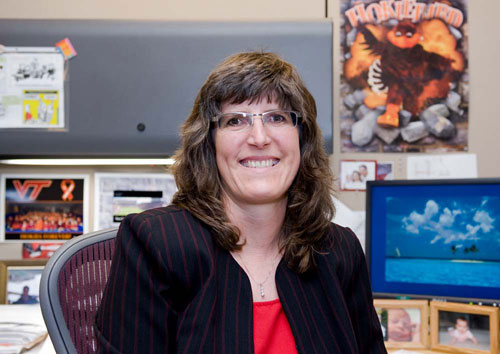
Heidi Derby, a project analyst and certified public accountant with JLab's Project Management and Integration group, is also the Coast Guard Auxiliary district captain for Sector Hampton Roads.
Growing up near the beltway in northern Virginia and Maryland suburbs, Heidi Derby didn’t do much boating. And there wasn’t a lot of water around when she went to Blacksburg to earn her degree. But this self-described "big Hokie fan" fell in love with all things aquatic when she married her husband, Gary, an electrical engineer, and moved to Hampton Roads in 1982. As a Certified Public Accountant with Jefferson Lab's Project Management and Integration group, a position she’s held for the last year – after 21 years in the lab's Finance group, she’s now working with Claus Rode and his team on the Department of Energy’s reporting for the 12 GeV Upgrade project along with any other projects that require Project Management reporting. "This is very specific work," she notes, "where all the aspects come together. Lots of changing parts and monthly updates. I love extracting data, and this is it." The group is also working on the Technology and Engineering Design Facility, which will provide additional space for the Superconducting Radio Frequency Institute and additional office and technical space for engineering groups as well as provide for the modernization of the existing Test Lab. "This is a very exciting project to be part of," Derby says. "DOE moved up the funding profile so we've been very busy." When she's not here crunching numbers, though, you can usually find Derby aboard "Hokie Time," the 33-foot Larson Cabrio 330 she and her husband bought. They live in Grafton, on the water, and what she calls her "second job" was born out of a need to learn boating. 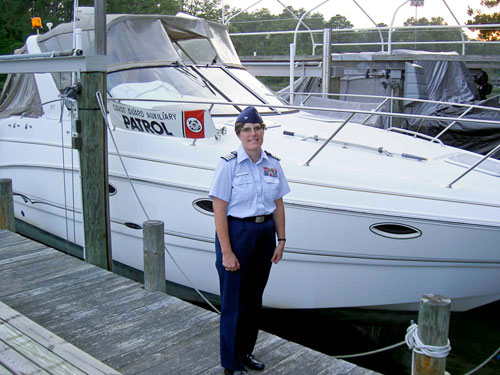
Heidi Derby ready for volunteer duty as District Captain for Sector Hampton Roads for the Coast Guard Auxiliary.
"My husband was brought up on boats. When I started boating with him, I told him that I needed to know everything about how to run the boat in case we were out and something happened to him," she recalled. Well, she learned that – and more. They took a boating and seamanship class through the Coast Guard Auxiliary and a new passion was born. This energetic couple joined the 35,000 volunteers across the United States who devote their time and talents to supporting the auxiliary, and Derby carries the weighty title of District Captain for Sector Hampton Roads, which means that Virginia and its 1,200 volunteers, except those in the northern Virginia/Washington D.C. area, come under her purview. She has a uniform identical to a Coast Guard uniform, with the exception that the gold trim is replaced by silver. It sounds like work and it's very time-consuming, but it's a heck of a lot of fun, she says. Her volunteers provide safety zones for events such as Fourth of July fireworks and the Langley Air Force Base air show and help out with the annual pony swim at Chincoteague. They often provide free boat inspections at area marinas and ramps, helping boaters to be as safe as possible on and in the water. They are also called upon to conduct Search and Rescue missions to help boaters in distress. And, of course, they teach boating education courses. She’s emphatic, though, about the limits of their duties. "We are not law enforcement," Derby points out. "We can't issue tickets and we can't board boats for any reason," she says. They can, though, talk with boaters about current maritime laws, such as the new one that went into effect on July 1 that requires anyone under the age of 21 who’s going to drive a jet ski to have taken a certified boating class. The Commonwealth of Virginia is phasing in the requirement that all boaters operating a boat greater than 10 horsepower will be required to have taken a boating class by the year 2016. Volunteers, she says, are an integral part of the Coast Guard mandate, and skills are needed in many areas. Not everyone does their duty on the water. "People can do whatever they want to do," she says. "We need help with publications, the websites, training, talking to kids at schools – you name it. We have a place for anyone who wants to participate." When they’re not on the water, Derby and her husband are often in it – indulging their joy of SCUBA diving – or on top of it in another form when they head west for their annual skiing trip in Utah. But if it’s an autumn Saturday, there’s one place away from the water to find them: at Virginia Tech football games. By Judi Tull Editor's note: For more information on volunteer opportunities with the Coast Guard auxiliary, go to http://www.cgaux.org . For information about Virginia's new Boating Safety Education requirements that go into effect on July 1, visit the Virginia Department of Game and Inland Fisheries at: http://www.dgif.virginia.gov/boating/ Boating Is Great Fun When Done SafelyThousands of boaters are taking to the water around Hampton Roads. Being out there with friends and family is a great way to enjoy summer fun…as long as you’re aware of the possibilities for problems and know how to handle them. Boating safely can make the difference between delight and disaster. Here are some recommendations and things to keep in mind: 2. Be aware of the danger of carbon monoxide poisoning. Many boaters think you have to be in an enclosed cabin to face this problem. In fact, the danger can come from a variety of sources such as inadequately ventilated canvas enclosures, exhaust gas trapped in enclosed places, blocked exhaust outlets and even another vessel's exhaust. This buildup can occur at slow speeds, while idling or when you’re stopped. Be aware that CO can remain in or around your boat at dangerous levels even if your engine or the other boat's engine is no longer running! There are some simple but critically important steps to take to protect yourself and your passengers from carbon monoxide poisoning. • Make sure you know where CO exhaust outlets are located on your vessel. 3. It's not enough to have life jackets on board. In a real crisis, there’s often no time to grab them and get them on. Wear them; all the time. Make sure all children have appropriate life jackets and are wearing them correctly. Federal law requires children under the age of 13 to wear life jackets while underway. Check State laws for any other requirements. 4. Operator errors account for nearly 70 percent of boating accidents. Take a boating safety class so you’ll know how to do it right from the very beginning. 5. Familiarize yourself with your radio equipment and how to quickly and efficiently contact help if you need it. You can read more about the Global Maritime Distress and Safety System (GMDSS) at: http://www.gmdss.com/ 6. Don’t drink and boat. They call it "BUI" – Boating Under the Influence. A couple of cold beers on a sunny day may seem like a good idea at the time, but they’re not. Nearly 25 percent of all fatal boating accidents involved drivers who had been drinking. 7. Don’t hesitate to contact the authorities if you spot an unsafe boater who’s endangering themselves or others. 8. Watch the weather. Have a good weather radio and keep your eyes up. Especially in Hampton Roads, dangerous storms, especially for smaller craft, seemingly come out of nowhere. Mother Nature doesn’t care who you are. Don’t tempt your luck. 9. Always let someone know where you're going and what time you expect to return. Happy boating! Industrial Hygiene Group Settles into New Location for Trailer 35
The Industrial Hygiene staff members have settled into Trailer 35's new location on the west end of the Accelerator Site include: (left to right) Jen Williams, Tina Menefee, Mary Boggs, Dick Owen and Brett Lewis.
Early in June, the Industrial Hygiene group of the Environment, Safety, Health & Quality Division resettled into its renovated and relocated "home," Trailer 35. The trailer is now located on the Accelerator Site, on the back (west) side of Hall B. It was relocated to an open area along Quark Place between Building 92 and the Hall B ramp. The move was necessary as planning and preparation proceeds for the Technology Engineering and Development Facility (TEDF) project, scheduled to start in FY10. The TEDF project expands the Test Lab to the south and will relocate the accelerator site gate to about the current location of the Test Lab cooling towers. The relocation provided an opportunity to provide suitable office spaces and a better layout for the Industrial Hygiene organization that provides support services across JLab. The phone numbers for the Industrial Hygiene group members – Jen Williams, Brett Lewis, Mary Boggs and Dick Owen remain the same. In addition Accelerator Division Safety Officer Assistant Tina Menefee has relocated to T-35 and her phone number remains the same. The Hazardous Waste and Chemical Storage Building (B-33) and the nearby Oil Shed, both under the management of the Industrial Hygiene organization, will remain at their current locations until a new facility is provided. IH reminds JLab staff and users to continue delivering hazardous waste and oil to the existing locations and not to T-35. Used batteries for recycling should be brought to Trailer 35 as in the past. Industrial Hygiene staff members invite lab staff and users to visit their new home. California Schools Win Dept. of Energy National Science Bowl Events; Va. Middle School Among Finalists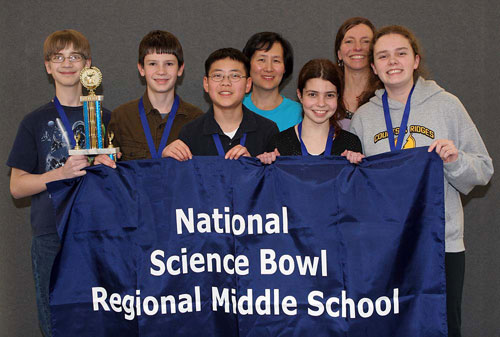
The Northern Virginia Homeschoolers were among the top 12 finalists at the Science Bowl Nationals that ended May 4 in Washington, D.C. The team advanced to the national competition after winning the Virginia Regional Middle School Science Bowl held March 7 at JLab. Here the team poses with the team trophy and banner they won on March 7. From left to right are: Tim Ruiter, Logan Meikle, Jason Lee, Coach Jean Lee, Lila Rieber, Coach Monica Herk and Jeannette Forbes.
High school and middle school teams from California won the 2009 U.S. Department of Energy National Science Bowl® on May 4 at the National Building Museum in Washington, D.C. Mira Loma High School from Sacramento beat Lexington High School from Lexington, Mass., in the high school national championship match. Hopkins Junior High School from Fremont, Calif., beat Jonas Clarke Middle School from Lexington, Mass., in the middle school national championship match. The high school national champion will receive an all-expense-paid science research trip to attend the International Science School at the University of Sydney, Australia. The top 16 high school and 16 middle school teams received a cash prize for their school science department — $1,000 for the high school teams and $500 for the middle school teams. "I congratulate the teams for their victories in the Department of Energy’s National Science Bowl," Secretary of Energy Steven Chu said. "The students in this competition displayed an impressive level of skill in a variety of scientific and technical subjects. We’re witnessing a resurgence of enthusiasm among our nation’s young people for finding solutions to our climate crisis, and these students embody the excitement and dedication to science that will be a critical factor in transforming the way we use and produce energy. Engaging our young students in activities like the National Science Bowl will help produce the next generation of leaders who will help the U.S. reduce its carbon footprint and remain the world’s leader in science, engineering and discovery." More than 500 students from 42 states, the District of Columbia, Puerto Rico and the U.S. Virgin Islands competed in this weekend's National Finals of the 19th annual DOE National Science Bowl. Earlier this spring, more than 20,000 students from across the country participated in regional Science Bowls. Sixty-seven high school and 36 middle school regional Science Bowl champions received all-expense paid trips to compete in the National Finals in Washington, D.C. The Northern Virginia Homeschoolers team won the Virginia Regional Middle School Science Bowl in March and finished in the top 12 at the Middle School Science Bowl Nationals, earning the team and its school a $500 cash award. Photos of the winning teams, biographical information about the teams and more information about the DOE National Science Bowl are available at: http://science.energy.gov/wdts/nsb/about/historical-information/ Milestones for mid-May through June 2009Hello Goodbye These Milestone entries, listed alphabetically, are full-time, term, casual and student actions posted by Human Resources during May and June 2009. Two dozen JLab career opportunities are currently posted at: https://careers.peopleclick.com/careerscp/client_jeffersonlab/external/search.do . For more information about employment at JLab, visit: http://www.jlab.org/div_dept/admin/HR/index.html . |
||
|
The On Target newsletter is published monthly by the Thomas Jefferson National Accelerator Facility (Jefferson Lab), a nuclear physics research laboratory in Newport News, Virginia, operated by Jefferson Science Associates, LLC, for the U.S. Department of Energy's Office of Science. Possible news items and ideas for future stories may be emailed to jlabinfo@jlab.org, or sent to the Jefferson Lab Public Affairs Office, Suite 15, 12000 Jefferson Avenue, Newport News, VA 23606
|


 Jefferson Lab User Guy Ron has won the 2008 JSA Thesis Prize for his work on low-energy proton form factors. The prize is awarded annually for the best Ph.D. dissertation resulting from research performed at Jefferson Lab.....
Jefferson Lab User Guy Ron has won the 2008 JSA Thesis Prize for his work on low-energy proton form factors. The prize is awarded annually for the best Ph.D. dissertation resulting from research performed at Jefferson Lab..... Jefferson Lab's Radiation Detector and Imaging Group, which developed a life-saving compact gamma camera for the improved detection of breast cancer, has been recognized with an award for "excellence in technology transfer" by the Federal Laboratory Consortium for Technology Transfer......
Jefferson Lab's Radiation Detector and Imaging Group, which developed a life-saving compact gamma camera for the improved detection of breast cancer, has been recognized with an award for "excellence in technology transfer" by the Federal Laboratory Consortium for Technology Transfer...... A new calculation clarifies the complicated relationship between protons and neutrons in the atomic nucleus and offers a fascinating resolution of the famous NuTeV Anomaly.......
A new calculation clarifies the complicated relationship between protons and neutrons in the atomic nucleus and offers a fascinating resolution of the famous NuTeV Anomaly.......